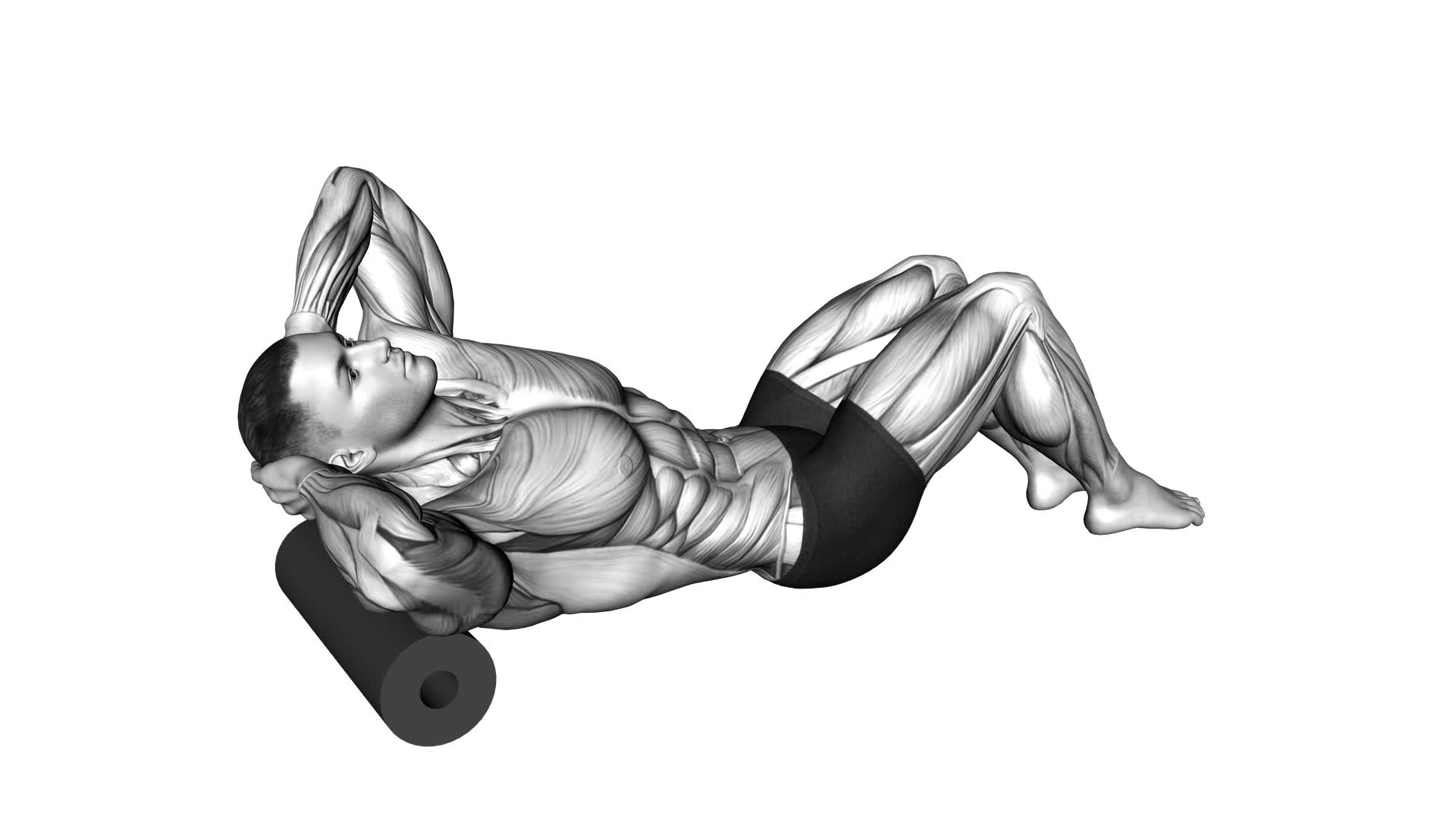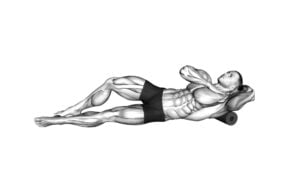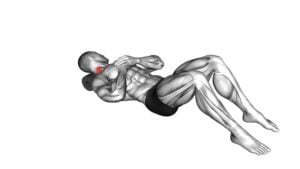Roll Shoulder Back Rotation Lying on Floor – Video Exercise Guide & Tips

Are you looking for a simple yet effective exercise to improve your shoulder mobility and strength?
Watch This Exercise Video
Look no further than the Roll Shoulder Back Rotation lying on the floor. In this video exercise guide, you'll learn the proper form and technique, as well as common mistakes to avoid.
With modifications and progressions, you can tailor this exercise to your fitness level. Maximize its effectiveness with our expert tips.
Get ready to roll those shoulders!
Key Takeaways
- Improved posture
- Increased flexibility in shoulder joints
- Corrects postural imbalances
- Strengthens muscles responsible for alignment
Benefits of Roll Shoulder Back Rotation
The benefits of the roll shoulder back rotation exercise are twofold: improved posture and increased flexibility in your shoulder joints. By regularly performing this exercise, you can correct any postural imbalances and strengthen the muscles responsible for maintaining proper alignment. This, in turn, leads to improved posture, as your shoulders are pulled back and down, opening up your chest and elongating your spine. Not only does this give you a taller and more confident appearance, but it also helps to alleviate any discomfort or pain caused by poor posture.
Additionally, the roll shoulder back rotation exercise targets the muscles surrounding your shoulder joints, increasing their mobility and range of motion. As you rotate your shoulders backward, you're actively stretching and strengthening these muscles, allowing for greater flexibility and improved movement. This can be especially beneficial for individuals who engage in activities that require a wide range of shoulder motion, such as athletes or those who perform manual labor.
Incorporating the roll shoulder back rotation exercise into your fitness routine can have significant benefits for your overall posture and shoulder mobility. Consistency is key, so aim to perform this exercise regularly to experience these positive changes in your body.
Equipment Needed for the Exercise
To perform the Roll Shoulder Back Rotation exercise, you'll need some equipment. The necessary equipment includes:
- A yoga mat or a comfortable surface to lie on
- A small towel or yoga strap
If you don't have a yoga strap, you can use a belt or a resistance band as an alternative.
Necessary Equipment for Exercise
You will need equipment for this exercise. To perform the Roll Shoulder Back Rotation Lying on Floor exercise, you'll require exercise equipment and exercise accessories. Here are the necessary items:
- Exercise mat: A comfortable mat will provide support and cushioning for your body while lying on the floor.
- Resistance band: This elastic band will add resistance to the exercise, helping to strengthen your shoulder muscles.
- Dumbbells: Adding weights to the exercise will further challenge your shoulder muscles and increase the effectiveness of the workout.
- Towel: A small towel can be used to support your head or neck during the exercise, providing additional comfort.
Equipment Alternatives for Exercise
To perform the Roll Shoulder Back Rotation Lying on Floor exercise without the necessary equipment, you can consider using alternative items that provide similar benefits. Here are some options to try:
- Resistance bands: These versatile bands can be used to add resistance to your movements, helping to strengthen and tone your muscles.
- Bodyweight exercises: Instead of using equipment, you can rely on your own body weight to provide resistance and challenge your muscles.
- Household items: Look around your house for items that can be used as makeshift weights, such as water bottles or cans of food.
- Towels or pillows: These can be used to support your body during the exercise and provide added comfort.
- Yoga blocks or foam rollers: These can be used to modify the exercise and make it more accessible or challenging.
Now that you know some alternatives, let's move on to discussing proper form and technique for the Roll Shoulder Back Rotation Lying on Floor exercise.
Proper Form and Technique
Ensure proper form and technique by engaging your core muscles and maintaining a neutral spine throughout the roll shoulder back rotation exercise. This will help you maximize the benefits of the exercise and prevent injury.
A common error to avoid is allowing your lower back to arch or lift off the floor. To maintain a neutral spine, think about pressing your lower back into the floor and engaging your abdominal muscles. Another common error is using momentum to swing your legs from side to side. Instead, focus on controlled movements and use your core muscles to initiate the rotation.
There are variations and modifications you can incorporate into the exercise to suit your fitness level. If you find the exercise challenging, you can start by performing smaller rotations or reducing the range of motion. Alternatively, if you want to increase the difficulty, you can hold a dumbbell or medicine ball in your hands while performing the rotations. Another variation is to perform the exercise on a stability ball instead of lying on the floor. This will further engage your core muscles and challenge your balance.
Remember to listen to your body and stop if you feel any pain or discomfort. It's important to maintain proper form and technique throughout the exercise to ensure you get the most out of it and avoid any potential injuries.
Common Mistakes to Avoid
Maintaining proper form and technique is crucial to avoid common mistakes during the roll shoulder back rotation exercise. By following these tips, you can ensure that you're getting the most out of this exercise while minimizing the risk of injury:
- Avoid rushing through the movement: Take your time and focus on the quality of each repetition. Rushing can lead to sloppy form and decrease the effectiveness of the exercise.
- Don't use momentum: Use your muscles to control the movement rather than relying on momentum. This will help engage the targeted muscles and prevent strain on other areas of your body.
- Keep your core engaged: A strong core is essential for stability and proper form. Make sure to activate your core muscles throughout the exercise to maintain a stable base.
- Don't lift your head off the floor: Keep your head in contact with the floor throughout the movement. Lifting your head can strain your neck and compromise your form.
- Avoid excessive shoulder movement: Focus on rotating your shoulders back without any unnecessary jerking or twisting. This will help isolate the targeted muscles and prevent strain on your joints.
By avoiding these common mistakes and maintaining proper form, you can get the maximum benefit from the roll shoulder back rotation exercise.
Now, let's move on to the next section to discuss modifications and progressions.
Modifications and Progressions
To progress the roll shoulder back rotation exercise, you can add resistance by using a resistance band or dumbbells. These modifications and variations can provide additional challenges and benefits to your workout routine. By incorporating resistance, you increase the intensity of the exercise, targeting your shoulder muscles even more effectively.
Using a resistance band allows for a wide range of motion, as you can adjust the tension to suit your fitness level. Start by wrapping the band around your hands and holding it at chest level. As you perform the roll shoulder back rotation, the resistance band will add resistance, making the exercise more challenging. This modification helps to strengthen the muscles involved in shoulder rotation and improves overall shoulder stability.
Alternatively, you can use dumbbells to add resistance to the exercise. Hold a dumbbell in each hand, starting with a weight that's comfortable for you. As you roll your shoulders back and rotate them, the additional weight provided by the dumbbells increases the load on your shoulder muscles, promoting strength and stability.
While these modifications can enhance the effectiveness of the roll shoulder back rotation exercise, it's important to note that they may also come with drawbacks. Adding resistance can increase the risk of injury if not performed with proper form and control. It's crucial to maintain proper alignment and stability throughout the exercise to avoid straining the shoulders or other muscles.
Incorporating these modifications and variations into your workout routine can provide you with new challenges and help you progress in your fitness journey. However, it's essential to listen to your body and consult a professional if you experience any pain or discomfort.
Tips for Maximizing the Exercise's Effectiveness
To maximize the effectiveness of the roll shoulder back rotation exercise, consistently incorporate proper form and control into your routine. Here are some tips to help you get the most out of this exercise:
- Engage your core: Keep your abdominal muscles tight throughout the movement to stabilize your spine and enhance the rotation.
- Maintain a neutral spine: Avoid arching or rounding your back. Imagine a straight line from your head to your tailbone.
- Control the movement: Slowly roll your shoulders back, focusing on the rotation rather than speed. This will engage the muscles more effectively.
- Breathe properly: Exhale as you rotate your shoulders back and inhale as you return to the starting position. This will help you maintain control and stability.
- Avoid common mistakes: Don't rely on momentum or use excessive force. Instead, focus on controlled and deliberate movements.
Remember, modifications and progressions can also help maximize the effectiveness of this exercise. Start with a smaller range of motion if needed and gradually increase it over time. You can also add resistance by using light dumbbells or resistance bands.
Stay consistent with your practice, and always listen to your body to avoid injury.
Frequently Asked Questions
How Many Repetitions Should I Do for the Roll Shoulder Back Rotation Exercise?
To determine the number of repetitions for the roll shoulder back rotation exercise, it's important to consider your fitness level and goals. Start with a comfortable number that challenges you, but doesn't cause strain or fatigue. As you progress, gradually increase the repetitions. Consulting with a fitness professional can provide personalized guidance.
Remember to always listen to your body and modify the exercise as needed. Regularly incorporating this exercise can improve shoulder mobility and posture.
Can I Do This Exercise if I Have a Shoulder Injury or Pain?
If you have a shoulder injury or experience pain, it's important to consult with a healthcare professional before attempting exercises like the roll shoulder back rotation. They can provide you with specific modifications that suit your condition.
In general, it's crucial to prioritize safety and avoid any movements that exacerbate your pain. Implementing shoulder pain prevention strategies, such as proper warm-up, stretching, and maintaining good posture, can also help protect your shoulders during exercise.
Is It Important to Warm up Before Performing the Roll Shoulder Back Rotation Exercise?
Before performing the roll shoulder back rotation exercise, it's important for you to warm up. Warming up helps increase blood flow to your muscles, which can prevent injury and improve performance.
It also prepares your body for the exercise by loosening up your shoulders and increasing flexibility. Additionally, warming up can help you avoid common mistakes during the exercise, such as using improper form or straining your muscles.
Can I Do This Exercise on a Yoga Mat Instead of on the Floor?
You can definitely do the roll shoulder back rotation exercise on a yoga mat instead of on the floor.
Using a yoga mat provides several benefits for floor exercises. It offers cushioning and support for your body, making the exercise more comfortable.
Additionally, a yoga mat provides better grip and stability, reducing the risk of slipping or sliding during the movement.
Are There Any Alternative Exercises That Target the Same Muscles as the Roll Shoulder Back Rotation?
There are alternative exercises that target the same muscles as the roll shoulder back rotation. These alternative exercises include seated rows, bent-over rows, and reverse flys.
Seated rows work the muscles in your upper back and shoulders, while bent-over rows target your back and arms. Reverse flys focus on your upper back and shoulders.
Incorporating these alternative exercises into your routine can help you engage the same muscles as the roll shoulder back rotation.
Conclusion
In conclusion, the roll shoulder back rotation exercise is a beneficial way to improve shoulder mobility and strengthen the surrounding muscles.
It can be done on the floor with minimal equipment and proper form is essential to avoid common mistakes.
Modifications and progressions can be made to increase the challenge as you become more comfortable with the exercise.
By following these tips, you can maximize the effectiveness of this exercise and enjoy its benefits.

Author
Years ago, the spark of my life’s passion ignited in my mind the moment I stepped into the local gym for the first time. The inaugural bead of perspiration, the initial endeavor, the very first surge of endorphins, and a sense of pride that washed over me post-workout marked the beginning of my deep-seated interest in strength sports, fitness, and sports nutrition. This very curiosity blossomed rapidly into a profound fascination, propelling me to earn a Master’s degree in Physical Education from the Academy of Physical Education in Krakow, followed by a Sports Manager diploma from the Jagiellonian University. My journey of growth led me to gain more specialized qualifications, such as being a certified personal trainer with a focus on sports dietetics, a lifeguard, and an instructor for wellness and corrective gymnastics. Theoretical knowledge paired seamlessly with practical experience, reinforcing my belief that the transformation of individuals under my guidance was also a reflection of my personal growth. This belief holds true even today. Each day, I strive to push the boundaries and explore new realms. These realms gently elevate me to greater heights. The unique combination of passion for my field and the continuous quest for growth fuels my drive to break new ground.



